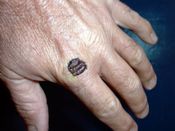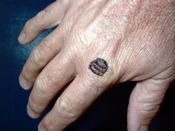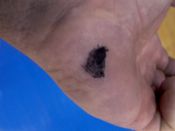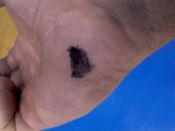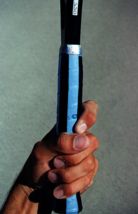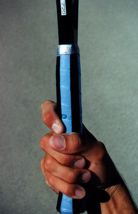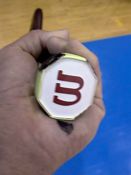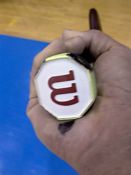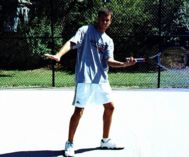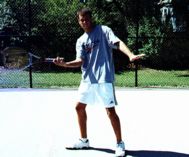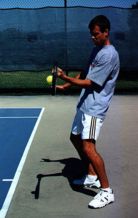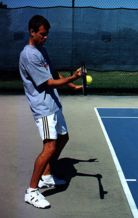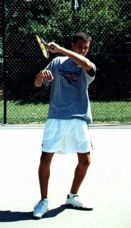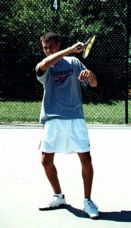March 2003 Article Turbo Tennis Archives:
Tennis Server
|

 |
Last month, I laid out the framework for what I call The Integrated Approach to Tennis. If you have not yet read this column, I strongly encourage you to do so. However, as a brief review, Integrated Tennis has the following components:
When all of these are addressed carefully and developed within the player (a process that never truly ends), the player is executing what I call Integrated Tennis. In teaching, coaching and competing, I have learned that all players win more frequently, and more importantly, grow more rapidly in their game when this integrated approach is in place. In past articles, I have addressed my thoughts on fitness, seeing the ball and stretching for flexibility. I invite the curious reader to refer to the Turbo Tennis Archives…there is a link on the sidebar to the left of this column that will take you to all my past articles. However, this month, I want to address the forehand stroke. Now, there are four typical grips used to hit a forehand, but I will address only one this month. Each month, I will take one grip/stroke combination and, in detail, explain the integrated approach to hitting the stroke properly. Eventually, we will work our way to the other key ingredients involved in Integrated Tennis. Before we begin, it is important to remind you that every stroke begins with a grip, which dictates the entire integrated process. Given the grip, the player will find that stance, backswing, contact point, finish and recovery are unique to each grip selection. As you can see, every properly executed stroke is a combination of integrated elements. I encourage players to experiment with the various grip/stroke combinations that will comprise the content of my articles, as we cover all the key strokes. You may find that some are just too different from your natural method of hitting a stroke that they should never be included in your arsenal. However, be patient. Use a wall or backboard to become familiar with the "new" stroke. You just may find that changing is not as severe as you initially imagined. You may also find that you want to include the "new" stroke for certain situations…using your regular or natural grip/stroke to be the most frequently used method. This month, I will focus on forehands that are struck with the Western Grip. This grip is quite common in the modern game of tennis. So the logical question the reader may have is: "What does this grip look like?" Well, below are some illustrations that may be of help in answering this question. It should be noted that the dominant hand’s index finger’s base knuckle and the dominant hand’s "heel" are very important in recognizing and identifying your grip. Here are two pictures that show what I mean by the "base knuckle" of the dominant hand. Note that I have included left and right handed images. You will note that I have darkened the knuckles with black magic marker. Here are two images of what I mean by the "heel" of the hand. Again, there are left and right images, and the area that is the "heel" is darkened with black magic marker. Given these areas of concern, I have shown below the two grips examined in this column. The first is the Western Grip. Again, you will see left and right handed images. In the Western Grip, the base knuckle is on the lower bevel and the heel is on the very bottom of the racquet. Please note that the black areas on the racquet grips represent the bevels. The Western Grip is often times the grip adopted by small children as they learn the game. This is quite understandable in that the Western Grip works best when the ball is bouncing high. For children, most balls bounce high because of their lack of height and stature. However, this grip can be very limiting on low bouncing balls. In fact, some adolescents who experience rapid growth spurts will find that their forehand seems to become a liability for a while. In time, however, they usually adjust to the change in their own height and find a way of striking the ball at a proper height. Because of its advantage on high bouncing balls, the Western Grip is often times the preferred grip by those who play tennis on clay courts. These surfaces (red clay or green clay) usually make the ball bounce high…right in the "strike zone" for the player with the Western Grip. The Western Grip forehand is best hit from an open stance. Now, in reality, no player can hit every forehand from a particular stance… particularly if he/she is on the run. However, whenever possible, try to hit from an open stance. The Western Grip, when hit from this stance, allows you to hit with maximum power while imparting lots of topspin. This spin makes the ball more likely to land inbounds…thus, giving you a larger margin for error. Here is what the open stance looks like. Note that the camera position is where the net would be located. Next, we must locate what is the proper contact point for this particular grip. When using the Western Grip, it is essential to make contact with the ball in front of your body. Again, this reality is, in part, why the open stance is so effective for this grip. Below, we see the proper contact point for the Western Grip. The last component in any stroke is the finish. I cannot emphasize how important having a consistent finish is to any stroke. Having photographed many of the pros on both tours, I have noticed that when the finish is not proper (even when other elements are as they should be) the stroke is usually weak or errant. When practicing, it is imperative to pay attention to fully finishing each stroke…and finishing it properly. Here is an image that shows the proper finish for the Western Grip. Notice that the finish is over the shoulder that is opposite to the dominant hand, and that, often times, the elbow of the racquet hand is facing the opponent. One of the great aspects of hitting a Western Grip Forehand from the open stance is that it naturally allows for a quick recovery to center court. When running and hitting from an open stance, you will automatically stop your sideways motion by landing on your dominant foot. This action allows you to very quickly reverse direction and drift or run back to the center of the baseline…as the situation dictates. One finally comment about all strokes (regardless of grip, etc.) is that they always benefit from a quiet head at the moment of impact. Like the golfer, tennis players should make a concerted effort to keep the head motionless at the moment the ball strikes the strings and for a second afterwards. Too frequently, I see players looking to see where their ball has been hit. In fact, you have much more time to get your vision back on the ball and the opponent than you might imagine. However, when we are feeling pressure or too eager to hit the big winner, we frequently forget to freeze the head at impact. This invariably leads to an errant shot. When you practice, don’t forget this important component to a successful stroke. Remember, every stroke begins with a grip. We then take a backswing. Some of us have "longer" strokes than others do. My advice is to take the shortest backswing that you can. I promise you that you won’t lose power (and if you did, you could easily adjust by having your racquet tension lowered)…. What you will gain is the ability to make the little adjustments necessary to hit the ball sweetly. When playing in windy conditions, natural surfaces like clay or grass, or when playing on very fast indoor surfaces… I promise you that the shorter backswing will pay dividends. Every stroke has an ideal stance and contact point that are really, in major measure, determined by the grip used. Finally, every grip/stroke dictates an ideal finish. When all of these elements are in place for any grip/stroke, you are executing an Integrated Tennis Stroke. My strong advice is to videotape yourself hitting this forehand. You will clearly be able to compare your execution to the images contained in this article. With consistent practice and attention to detail, I am sure that this stroke will help you to become a tennis overdog!!!
1996 - 2002 | 2003 - Present
This column
is copyrighted by Ron Waite, all rights reserved. Questions and comments
about these columns can be directed to Ron by using this form.
Ron Waite is a certified USPTR tennis instructor who took up the game
of tennis at the age of 39. Frustrated with conventional tennis methods
of instruction and the confusing data available on how to learn the
game, Ron has sought to sift fact from fiction. In his seven years of
tennis, Ron has received USTA sectional ranking four years, has successfully
coached several NCAA Division III men's and women's tennis teams to
post season competition, and has competed in USTA National singles tournaments.
Ron has trained at a number of tennis academies and with many of the
game's leading instructors.
In addition to his full-time work as a professor at Albertus Magnus
College, Ron photographs ATP tour events for a variety of organizations
and publications. The name of his column, TurboTennis, stems from his
methods to decrease the amount of time it takes to learn and master
the game of tennis.
|



October 2022 Tennis Anyone: Patterns in Doubles by John Mills. September 2022 Tennis Anyone: Short Court by John Mills. |
 You will join 13,000 other subscribers in receiving news of updates to the Tennis Server along with monthly tennis tips from tennis pro Tom Veneziano.
You will join 13,000 other subscribers in receiving news of updates to the Tennis Server along with monthly tennis tips from tennis pro Tom Veneziano. 
